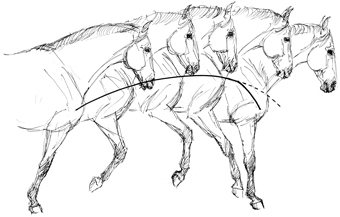Training in two steps
Inherent crookedness
During the education according to ARR the natural crookedness of the horse will be corrected before the horse will even get saddled. Only if the horse learned already how to work with bend lines, shear and centrifugal forces, to lift the trunk and swing with the back upwards, a stress-free riding without damaging the health will be possible.
Only rarely does one see a horse with his back truly swinging upward. Words cannot describe the feeling of riding such a horse. Our team at the ARR center will enable your horse to build strong, upward-swinging backs. Only then will your horse lead a long and healthy life as a ridden horse; only then can he receive and process the rider's impulses. Finding his physical balance will also make your horse more self-confident.Our training is suited for horses of all ages, breeds and levels of training. We have achieved sustained success with horses who had been having serious health problems. We also train young horses and gently prepare them for their life as a ridden horse. Training your horse in concordance with our concept will make you discover the easy way of riding. Stiff and insubordinate horses are ill at ease. Our training will provide you and your horse with a new awareness of life and riding.
The facts are these: horses who have been trained by the ARR team can be ridden without any strain on their ligaments and backs – their whole life long. Your horse will thank you for it.
Training step 1: functional lunging training
Throughout our method of training the horse with a cavesson, the horse learns to shift his main body weight to his hindquarters and to lift his trunk. This process of diagonal shift, let us call it «straightness training», is usually completed after 3 to 4 weeks, whether the horse is green or a 14 years old grand prix horse.
The first step of ARR training is completed if the straightened horse shows rhythm, impulsion and
suppleness on the lunge. Four goals of the FN training scale have now been achieved. The back is swinging upwards, the cannon bones are parallel in movement, the hind legs stay in line with the front legs, the tail swings loosely. The horse is ready and able to begin work under saddle – the second training step.
Training day 1
Training day 5
Training week 3
Training step 2: anatomically correct riding
The straightened horse’s back is now swinging upward. The muscle perfusion is optimal and hence is the metabolic activity. The horse is feeling good and becomes increasingly self-confident. The strain on his joints is minimal as the body is swinging upward, away from the ground. He is now ready to carry a rider.
The movement pattern trained on the lunge is to be maintained under saddle. When riding in an arena, the rider has to pay attention that the horse does not relapse into old movement patterns, i.e. put his main weight on his handed foreleg. The first aspect of anatomically correct riding is the rider’s independent seat.
Starting from this solid basis, the remaining goals of the FN training scale can be tackled: contact and collection.
